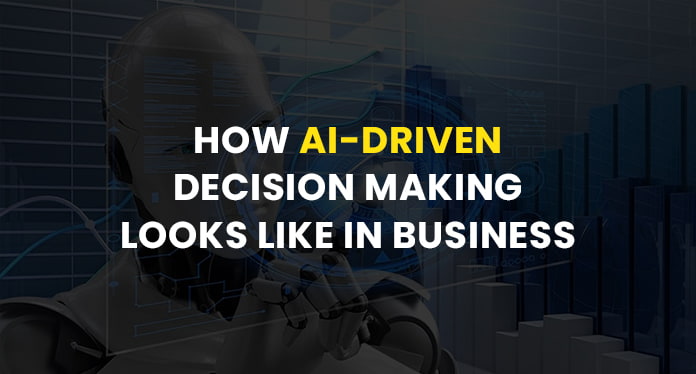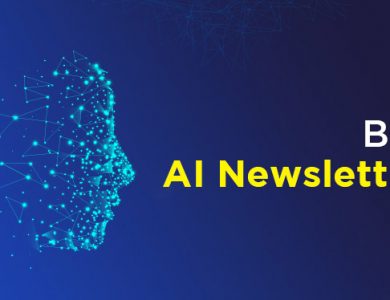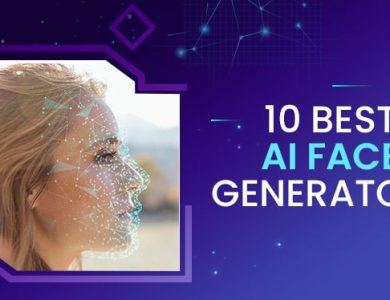How AI-Driven Decision Making Looks Like in Business

Data is the new oil, fueling the engines of the modern business world.
Data has become the lifeblood of organizations, empowering them with valuable insights and the potential to make informed decisions. However, with the sheer abundance of data at our disposal, the task of processing and extracting meaningful insights has grown increasingly challenging.
According to McKinsey, the future holds promising prospects for the integration of AI technologies in businesses. Their predictions indicate that by 2030, 70% of companies will leverage at least one form of AI technology. This showcases the growing recognition of AI’s potential to revolutionize various industries.
The study also reveals that nearly half of large enterprises will have fully embedded AI technology within their operational processes by the same year. This projection implies a significant shift towards AI becoming an integral part of daily business operations, rather than merely a supplementary tool.
But what exactly is AI?
AI, in its simplest form, refers to the simulation of human intelligence in machines programmed to think and learn. However, in recent years, AI has evolved and distinguished itself into 3 distinct types of intelligence: Artificial Intelligence, Augmented Intelligence, and Automated Intelligence.
- What we mean when we talk about Artificial Intelligence (AI) is the development of computer systems that can take on responsibilities that would normally need human intellect. AI enables businesses to examine massive data sets and extract actionable insights at a scale and speed impossible for people alone.
- While AI can help humans make better decisions, Augmented Intelligence acknowledges that in the end, humans’ knowledge and instincts are what matter most. The goal of Augmented Intelligence is to improve decision-making by combining human intellect with AI technology.
- To automate dull and repetitive processes, Automated Intelligence makes heavy use of AI-driven algorithms and robotic process automation. It allows businesses to improve their efficiency, cut down on errors, and boost output. It frees up humans to focus on higher-value tasks that need their unique blend of creativity and analytical reasoning.
How can businesses leverage the synergy between human and artificial intelligence?
AI offers a myriad of benefits to organizations across industries. According to a study conducted by Deloitte, these are the key benefits that arise from implementing AI in the workplace:
Product Development
Developing a comprehensive product development strategy involves navigating a labyrinth of intricate processes and considerations. Engineers spend a significant amount of their time and resources into repetitive tasks that slow down the development lifecycle. Developers can utilize AI as a co-pilot that can automate such tasks, suggest fresh design approaches, test prototypes, and accelerate the design iterative process.
Internal Operations Optimization
Increasing workload and complexity of services allows little to no time for leaders to get a complete picture of the organizational operations that run in cross-functional and non-linear hierarchies. Operational decisions are high-stake and diving headfirst without compelling insights can incur losses. Digital tools that employ AI, ML, and other technologies can analyze data with utmost granularity to offer much-needed transparency and objectivity.
External Operations Optimization
In order to achieve their next growth target, businesses must establish comprehensive and streamlined operations processes, both internally and externally. Instead of merely addressing sporadic issues as they arise, it is far more advantageous to adopt a strategic approach. To maximize output, strategies must be optimized, which necessitates identifying and rectifying irregularities, loopholes, and bottlenecks. While this may seem easy, in reality, numerous factors and blindspots can hinder decision-makers from making the right choices. AI has proven particularly valuable in predictive maintenance, offering suggestions for enhancing manufacturing equipment, and anticipating supply and demand, among other applications.
Better Decision-Making
Machines are surely better at making business decisions since they can analyze vast amounts of data faster and more accurately. Unlike their human counterparts, machines do not experience fatigue or exhaustion and are not biased by emotions or preferences, making decisions more objective. However, the best practice is to combine the strengths of humans and machines, as machines alone lack an understanding of nuances and context.
Let's look at how AI helps decision-making...
Just five to ten years ago, decision-making relied heavily on human judgment, often influenced by subjective factors such as personal experiences and preferences. The integration of AI technologies has brought about a paradigm shift, augmenting human decision-making with data-driven insights and analysis.
Decisions can be grouped into three main categories: structured, unstructured, and semi-structured. The classification depends on the certainty levels and agreement surrounding the problem.
Structured decisions are clear-cut solutions. These decisions are characterized by well-defined processes and established guidelines, leaving little room for ambiguity or personal judgment.

Source: Eric Colson
On the other hand, unstructured decisions are more subjective, relying heavily on the preferences and experiences of the individual making the decision. These choices lack a straightforward solution and may involve various factors, making them more challenging to navigate.
Somewhere in the middle lies semi-structured decisions. These decisions blend elements of both structured and unstructured categories. AI plays a crucial role in assisting human judgment across these decision types. It aids decision-makers by locating and selecting relevant inputs, identifying and analyzing appropriate data, solving decision models based on predefined conditions, and presenting the results in a comprehensible manner. By complementing human judgment with AI-powered insights, businesses can make more informed decisions, backed by data and objective analysis.

Source: Eric Colson
The volume of data generated by businesses today is staggering, and dealing with this data can be overwhelming. Gartner, a renowned research and advisory firm, emphasizes that businesses are being digitally disrupted by the sheer amount of data they must handle. By leveraging AI, businesses can extract meaningful patterns, trends, and correlations from vast data sets, enabling them to make data-driven decisions and uncover valuable insights.
According to McKinsey, the power of AI in decision-making goes beyond improving organizational efficiency and effectiveness. It states that AI decision-making has the potential to reshape the world economy, contributing an additional $13 trillion by 2030, which equates to an extra 1.2% of the global GDP.
Let’s explore some key ways how AI impacts decision-making:
Data Processing and Analysis
Processing and analyzing vast amounts of data at a speed at which AI can is impossible for humans alone. This speed and precision enables businesses to extract valuable insights and identify patterns without difficulty.
Predictive Analytics
Predicting future trends and outcomes have a major impact on the day-to-day decisions that large organizations make. The predictive analysis capabilities that AI possesses can empower businesses to generate accurate forecasts and scenarios.
Enhanced Risk Management
Decision-making through AI algorithms enhances risk management capabilities by identifying potential risks and developing mitigation strategies. By analyzing historical data, market trends, and external factors, AI algorithms can flag potential risks, predict their likelihood, and suggest appropriate actions.
Personalized Recommendations
AI has transformed the eCommerce industry with powerful recommendation systems that can analyze customer data, preferences, and behaviors to provide personalized recommendations.
How impactful are AI decision models?
1. Volvo's Early Warning System
One compelling example of the impact of intelligent decision models can be seen in Volvo’s innovative use of the Internet of Things (IoT) and AI technologies to uphold and maintain its safety reputation.
Recognized as a leading automotive manufacturer renowned for prioritizing safety, Volvo has embraced AI to develop an early warning system that predicts breakdowns and failures in their cars, thereby ensuring proactive maintenance and minimizing potential risks on the road.
By leveraging IoT sensors embedded within their vehicles, Volvo collects a vast amount of real-time data on various parameters such as engine performance, tire pressure, brake wear, and more. This continuous stream of data is then processed and analyzed using AI algorithms, enabling the early detection of potential issues that could lead to breakdowns or safety hazards.
2. Deloitte's TAX-I Solution
TAX-I is an innovative tool developed by Deloitte that leverages AI to analyze and visualize the relationships between tax cases, providing valuable insights and predictions for professionals in the legal and tax fields.
The tool visually depicts the relationship between a new case and its predecessors with the help of interactive charts. This visualization allows professionals to grasp the connections and similarities among various cases, enabling them to draw insights and learn from past rulings. The size of each dot on the chart indicates the relevance of a case based on the number of references it has, offering a quick assessment of its importance within the legal context.
TAX-I is also capable of generating case summaries. While they may not be written as perfectly flowing texts, they provide a concise overview of the case content.
3. Infervision's Lung Cancer Detection
Lung cancer is one of the leading causes of cancer-related deaths worldwide and detecting it in its early stages is crucial for increasing the chances of successful treatment. However, accurately interpreting CT scans for early signs of lung cancer can be challenging and time-consuming for radiologists.
Infervision, a medical technology company, developed an AI-powered system trained with advanced algorithms to review CT scans and identify early signs of lung cancer.
This technology-driven solution addresses the challenges faced by radiologists with the help of deep learning algorithms trained to analyze and interpret CT scans. The AI model, which has been trained on a vast dataset of lung scans, can recognize patterns, anomalies, and potential indicators of lung cancer imperceptible to the human eye.
What's the future outlook for AI decision-making?
The rapid advancement of AI technology necessitates a culture of continuous learning and adaptation in the business landscape. As AI becomes more prevalent and sophisticated, it is vital to ensure transparency, accountability, and fairness in their deployment. Organizations must prioritize ethical considerations, such as data privacy, algorithmic bias, and the impact on marginalized communities. Striking a balance between innovation and responsible AI practices is paramount to building trust and ensuring the positive impact of AI on society.
The Importance of Responsible AI Deployment
It is essential for organizations to establish governance frameworks and ethical guidelines to supervise the development, deployment, and use of AI systems. By promoting transparency, accountability, and explainability in AI algorithms, businesses can build trust and ensure that AI-driven decisions align with ethical standards.
Implications for Employment and Workforce Dynamics
While AI can automate routine tasks and enhance productivity, it may also disrupt certain job roles and industries. Businesses must proactively address changes by reskilling and upskilling employees, creating new roles to complement AI technology, and fostering a culture of lifelong learning.
Are you ready to take the plunge?
The time has come for businesses to embrace the power of AI-driven decision-making. Leaders cannot afford to lose valuable time manually analyzing data when AI algorithms can rapidly process and provide valuable insights.
By harnessing the potential of AI, organizations can unlock new levels of efficiency, innovation, and competitiveness in today’s data-driven world. The future is here, and the opportunities await – so are you ready to take the plunge?



